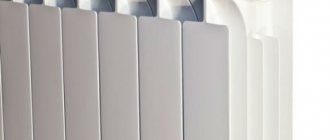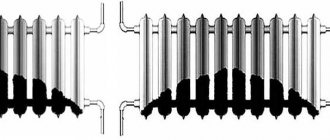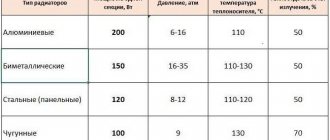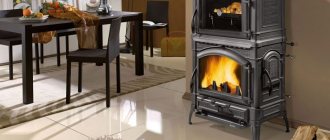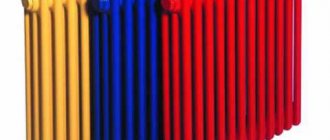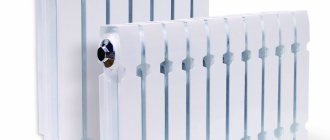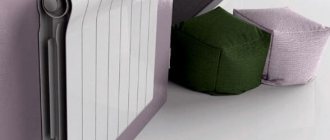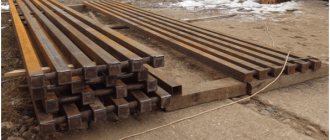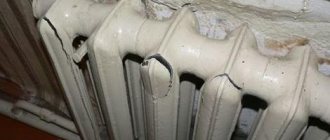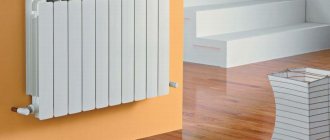Essential attributes of modern life are high-tech gadgets, innovative materials, and creative ideas. But not everyone likes this dominance of progress. Many people prefer to surround themselves with things with history, vintage, retro, or even antiques, if they have the financial means for this. Classic conservative interior styles are always relevant; designers create them using real antique or antique-style furniture. But in a home furnished with elegant antique furniture, heating devices of the 21st century look like alien elements. Cast iron radiators made in retro style look much more organic.
Antique-style radiators, like their antique prototypes, are made of cast iron. It was also used to make the first batteries, which began to be produced in the second half of the 19th century. After the appearance of the first cast iron heating radiators, they were made exclusively from this metal for a long time. “Accordions” made of cast iron were widely used for arranging heating systems for various purposes: residential apartments, houses and cottages, commercial establishments, administrative buildings, etc. Due to their widespread use over a long period of time, even the twentieth century in terms of heating began to be called cast iron.
If the design of radiators of the late 19th and early 20th centuries was varied, then the look of standard cast iron radiators from Soviet times can only be called boring. With the advent of batteries made of other materials, lighter ones, providing high efficiency heating systems, the demand for simple standard cast iron radiators has fallen. But the situation has changed radically with the advent of cast iron retro radiators on the market. Their spectacular design evokes admiration, and the variety of models makes it difficult for buyers to choose.
Reliability and durability
Heating batteries can be steel, copper-aluminum or simply aluminum, bimetallic and cast iron, but only the latter have passed the test of time and proven high reliability. For example, today the oldest, but properly functioning cast iron radiator in the heating system, which was produced and installed 108 years ago, is officially registered. Today, manufacturers of retro radiators use modern technologies for melting cast iron and casting batteries of various shapes with spectacular relief patterns. Heating devices are subjected to special kiln firing, priming and drying in special chambers.
Subtleties of cast iron battery production
Modern antique cast iron radiators are considered designer heating devices. For their production, artistic casting is used, which makes it possible to obtain beautiful convex patterns. Most vintage batteries have feet and sit on the floor. This design is not only gorgeous, but also practical - you don’t have to think about how to hang a heavy structure on the wall. In addition, a floor-standing unit is more efficient in terms of heat transfer - precious heat will not be wasted on heating a nearby wall.
Finished products are treated with abrasion-resistant dyes that imitate bronze, silver, and gold. No less popular are black, chocolate, emerald and white models. The coating can be matte or shiny, as well as with an aging effect, emphasizing the relief of the ornament. Manufacturers try to please all fans of antiquity and use recognizable motifs from various eras for artistic casting: baroque, rococo, classicism.
Specifications
We have already named one of the reasons why Soviet cast-iron heating radiators lost their popularity - a monotonous, dull design. But besides this, “accordions”, as they were aptly dubbed by the people because of their characteristic shape, had much weaker heat transfer than the aluminum analogues that appeared, and then bimetallic devices. Advanced cast iron technology made it possible to correct design flaws.
The technical characteristics have also changed significantly. For radiators of the MS-140 type, produced in Soviet times, the maximum operating pressure was only 6 bar; for current “antique” batteries, this figure is much higher. For example, retro radiators of the domestic brand EXEMET and the Czech brand VIADRUS operate normally at a pressure of 10 bar, and are tested at 15. Turkish devices of the Demir Dokum brand operate at a slightly lower pressure of 9 bar, but are tested the same fifteen.
A number of European manufacturers of antique-style batteries, for example, the German GURATEC, produce devices with an operating pressure of only 6 bar. Their products are aimed at consumers from European countries and are not intended for use in Russian realities.
But if there are no problems with the working pressure of cast iron radiators, then nothing has changed with heat transfer. Even in modern cast iron batteries produced using new technologies, it is weak. Nothing can be done about this, because heat transfer directly depends on the thermal conductivity of the material - in this case, gray cast iron. Let's give an example: if we take one section of a retro battery of the Demir Dokum brand, the mounting height of which is 500 mm, then the power of its heat flow will be equal to 160 W. For a bimetallic section with similar parameters, this figure will be at least 190 W. The heat transfer of the bimetallic section is much higher. The thickness of the battery walls plays an important role in this. In order for brittle cast iron to withstand the required coolant pressure, its layer must be thicker than the layer of steel or silumin.
As for the dimensions of antique batteries, the center distance and height vary slightly among all manufacturers. Average center distances can be 350, 500, 600, 750, 800 and 950 mm. But in terms of width, even within the line of one manufacturer, the values can differ significantly, since the shapes and designs of retro batteries are extremely diverse.
Recommendations for selection
The price of cast iron retro batteries depends on the design - the complexity of the cast surface, the bas-relief pattern, and the quality of painting.
The technical characteristics of radiators are important:
- height;
- width;
- depth of sections;
- thermal power value.
Maximum durability of a painted surface can only be achieved if certain conditions are met. After applying special dyes, the products are placed in thermal chambers for drying at high temperatures and controlled humidity. It is impossible to replicate this technology at home, so it is more profitable to purchase ready-to-install cast iron batteries.
For the initial calculation of the number of devices, the specific power coefficient of the heating system is used, which is taken equal to 100 W/m2. If the room area is 90 m2, then 9000 W of heat will be required. If the average thermal power of one section is 150 W, then you will need to buy 60 sections. They are connected and placed most often under window sills. If there are six windows with the same dimensions, then you get 6 heating devices from 10 sections.
When calculating the required number of heating radiators, specific climatic conditions must be taken into account. It is obvious that in the Arctic Circle the winter frosts are stronger than in the central part of Russia. Calculations are made for each room separately. Then a safety factor is added to the power of the heating devices, which is 10–15%.
Criterias of choice:
- The design of the battery must match the interior of the room.
- Cost is often a deciding factor.
- Heat dissipation directly affects the number of batteries. The greater the efficiency of the radiator, the fewer sections will be required.
- Reliability must be guaranteed by the manufacturer.
- Durability of cast iron radiators (tested by time).
- The size depends on the number of sections, as well as on the height of the window sill, where the batteries are most often installed.
- Weight is only important during transportation and preparation for installation. If the walls are made of lightweight concrete, then you need to choose a floor option with legs.
For heating a cottage, the operating pressure in the system is insignificant, but in multi-story buildings it reaches high values. It is worth taking this factor into account and looking at the permissible pressure specified by the manufacturer in the product data sheet.
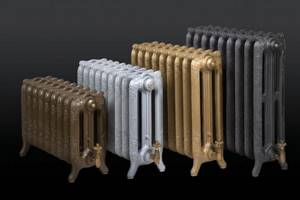
Types of radiators in retro style
An important feature by which retro batteries can be classified is the way they are fixed. Depending on it, “antique” radiators are:
- Hanging - this type of battery allows designers to smoothly introduce stylized heating devices into the interior. With suspended models it is easier to make a hidden connection. They are usually mounted on mounting hooks pre-installed into the wall. Hanging radiators in retro style look impressive, neat and aesthetically pleasing.
- On legs - such batteries are universal in installation, they do not put a load on the walls, so they are suitable for installation even near a plasterboard partition. Equipping heavy cast iron radiators with beautiful shaped legs is the optimal solution, especially if the room has a reliable floor and the walls are not permanent. Batteries on legs are installed quickly and easily, but the floor must be durable and not sloped.
By design, antique radiators are divided into:
- Sectional - allow you to increase the battery to the required size before or during operation by attaching additional segments of identical parameters and configuration. Sectional retro radiators are in active demand due to this possibility of adjusting their heating power.
- Monolithic - they can not be found as often as sectional ones; they are made mainly to order, for a specific project. In practice, monolithic radiators have proven to be more reliable than sectional ones. They are made of one-piece casting and do not have connecting seams, which minimizes the risk of leaks.
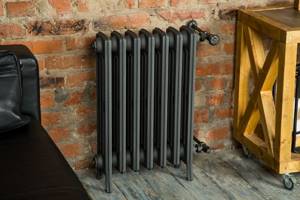
Advantages and disadvantages

Heating cast iron radiators have many positive characteristics:
- Long period of operation. The durability of the batteries is due to the thickness of the walls made of durable high-quality alloy. Manufacturers have established a product service life of up to thirty years. But in practice, retro radiators can operate for much longer.
- High corrosion resistance. Thanks to this property of cast iron, the batteries are not afraid of exposure to oxygen during draining of the heating system.
- Resistance to high temperatures. Cast iron appliances can withstand an increase in temperature when the coolant is heated to one hundred and fifty degrees.
- Long-term heat retention. Cast iron radiators cool down slowly when the heating is turned off. Fifty percent of the heat of the product will be lost only after two hours.
- Increased level of working pressure. The maximum excess pressure of retro batteries exceeds nine atmospheres, which allows the installation of heating devices in central heating systems.
- Relatively low cost. Old-style cast iron batteries are much cheaper than products made from new materials.
Cast iron batteries have few disadvantages:
- Weight. Each individual section weighs at least four kilograms. It is very difficult for one person to lift and install a cast iron radiator.
- Long warm-up time. When heated, cast iron releases heat to surrounding objects.
The appearance of the cast iron radiator can be highlighted as a minus. But this only applies to old standard products. New models are made in various artistic styles. Their price is much higher than simple “domestic” batteries.
The appearance is determined by the buyer
Cast iron retro radiators are often supplied to the market in factory primer, without a final paint coating. This is done specifically so that the buyer has the opportunity to independently choose the finishing option for the purchased batteries. Sellers can offer the following design options for heating devices:
- matte monochrome painting with a choice of colors according to the RAL scale;
- two-color painting with highlighting of the ornament;
- painting with polishing varnish;
- patination of bronze, copper, silver.
Comparison with other types of batteries
Taking into account the lower cost of more technologically advanced modern heating devices made of steel and aluminum, one must take into account their lower durability. They rust faster from the inside, so they will have to be replaced more often during major repairs. Cast iron retro heating radiators are an excellent option for rooms decorated in an antique style using fine wood, marble, and expensive accessories.
Does it make sense to change a design that has been proven over many decades of good service? The operating principle and internal structure of cast iron batteries remain almost the same as a hundred years ago. But when the need arises to replace reliable heating devices with more modern ones, you need to pay attention to alternative options.
Heaters are made from the following materials:
- aluminum;
- steel;
- bimetal;
- cast iron.
Aluminum creates galvanic couples with other conjugated metals. This greatly accelerates corrosion and reduces trouble-free service life. In bimetallic radiators this disadvantage is especially pronounced.
With periodic heating using units for burning solid organic fuel, massive radiators retain heat longer. On the other hand, using aluminum or steel batteries can warm up the room faster.
Modern heating devices have other advantages compared to cast iron:
- improved thermal conductivity;
- slight inertia;
- lighter weight for easier installation;
- minimum internal volume for coolant;
- low cost.
The design features of the batteries made of steel and aluminum allow the installation of individual thermostats that automatically select the most economical room heating mode. In this case, it is necessary to monitor the quality of the coolant: install filters, soften the water, using chemical reagents.
In summer, the system must be completely filled with water. If the liquid leaks, then in conditions of humidity and access to oxygen, corrosion processes will significantly accelerate, the metal will rust, and major repairs will have to be done ahead of time with the replacement of individual sections or radiators.
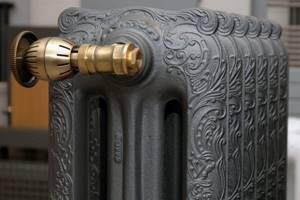
Why we choose cast iron retro
The main argument in favor of this choice is the magnificent design of radiators, stylized in antique style, with exquisite patterns, spectacular decor, a variety of shapes and colors. But there are other advantages to this type of battery. These include:
- Long service life - cast iron is not afraid of corrosion, and it is also not afraid of prolonged contact with coolants with aggressive chemical properties. Thanks to this, retro-styled batteries last for a very long time; only manufacturers provide a guarantee for several decades, so a cast-iron device can easily be used for half a century.
- Versatility of application - cast iron retro radiators made using new technologies are able to withstand high coolant pressure, so they can be installed at facilities for any purpose, with the exception of multi-apartment high-rise buildings.
- Inertness - thick-walled cast iron radiators heat up slowly, but these heating devices cool down longer than any other.
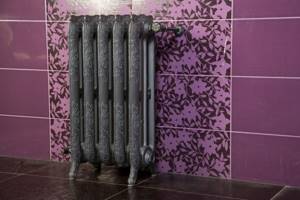
Let's talk about the cons
The main disadvantage of retro radiators is their high cost. Their price can be double, triple, or even more than the cost of aluminum analogues. Another important disadvantage that makes it difficult to transport and install stylized cast iron batteries is the heavy weight of the devices. In addition, radiators of this type contain a large volume of coolant, which increases their inertia and prevents the use of thermostatic valves. Well, we have already mentioned weak heat transfer. That is, to heat a room with a cast iron radiator, you need to use a larger number of sections than is required for, for example, a bimetallic radiator. The increased number of sections in the battery automatically increases the cost of the retro heating device.
Advantages of cast iron radiators
A heating radiator made of cast iron has a long service life and does not require special maintenance.
Along the long path from the thermal power plant to the house, the quality of the coolant (hot water) decreases. Thus, aggressive liquid enters the radiators, which can provoke corrosion of the batteries from the inside.
Cast iron batteries are neutral towards poor water quality - they are not afraid of corrosion. If you periodically service cast iron batteries - wash them and change the gaskets between sections, they will last 50 years or more.
Another advantage is the ability of cast iron radiator batteries to retain heat. Cast iron batteries take a relatively long time to heat up, but after turning off the heating they still give off heat for a long time.
The nuances of installing retro batteries
If you bought antique-style radiators without a finishing coating, we recommend painting them or applying another finish before installing the batteries in the system and connecting them. This way, the wall on which they are mounted will not interfere with you, and the high temperature of the device connected to the heating system will not become a problem. Take care of the base for mounting the radiator: you need a solid floor for floor-mounted installation of the radiator or a solid wall into which brackets for hanging wall-mounted models are mounted.
It is advisable to lay the coolant lines for connecting the radiator to the system secretly, in the wall or under the floor, after installing the device in a permanent place. This is due to the fact that often the interval between the axes of retro batteries has significant errors; pre-installed pipes may not align with the nozzles.
When choosing elements of shut-off valves for a system made in retro style, you need to maintain stylistic unity. Modern taps and plugs will look simply ridiculous on “vintage” radiators. To prevent such obvious dissonance, it is necessary to purchase and install retro-style faucets, modern, but outwardly imitating ancient ones.

Brown insulator, 5 pcs.
Rules for installing retro batteries
You can begin installing radiators only after checking the connections between sections. Tightness is ensured by gaskets made of heat-resistant rubber or paronite. The batteries are placed at a distance of 30–50 mm from the wall to ensure convective heat exchange. Systems with natural circulation are installed with pipes sloping in the direction of coolant movement.
To carry out proper installation, you must be guided by the “Building Norms and Rules” (SNiP):
- Determine the exact location for installing the radiators.
- Install brackets for pendant batteries.
- Equip radiators with plugs, air release valves, shut-off valves, and adapters.
- Install the heating devices in their places.
- Install the piping.
- Connect the radiators to the inlet and outlet pipes of the heating system.
- Remove the protective film from the surface of the sections.
The connection of heating devices to the heating system depends on the chosen flow pattern of the coolant, as well as on the location of the main pipeline in multi-storey buildings: with lower wiring in the basement or with upper wiring - on the technical upper floor.
There are three main ways to connect radiators:
- Bottom connection. Most often used in cottages. This method allows you to hide pipes under the floor and favorably emphasizes the aesthetics of designer radiator models.
- Lateral connection. Used for heating systems in multi-storey buildings. The supply pipe is connected to the upper futark, and the return pipe is connected to the lower one. This is the most efficient connection scheme in terms of heat transfer from radiators.
- Diagonal method. It is used for two-pipe horizontal distribution for one-story buildings. The supply pipe is connected to the top of the heating device on one side, and the return pipe is connected to the bottom on the other side.
To connect radiators to the pipes of the heating system, valves and taps are used, stylized as antique designs. Products of this type are manufactured by Italian companies Carlo Poletti and Rubinetterie.
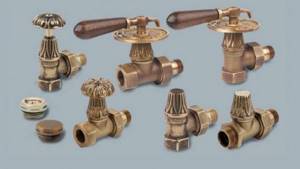
Brief overview of popular manufacturers
Retro radiators of both domestic and foreign production are represented on the Russian market of heating devices. Among Russian batteries, the most popular are Radimax and Exemet. Their products are spectacular sectionals, patterned and smooth. Such radiators have gained recognition not only in Russia, but also among domestic consumers. Products are successfully exported to a number of foreign countries. The collections of these companies are represented by a wide model line. Spectacular batteries are also distinguished by a variety of finishes.
Popular foreign brands are represented by the trademarks Viadrus, Demir dokum and GuRaTec. Viadrus is a well-known Czech brand that has been producing retro wall and floor radiators equipped with legs for many years. The company has established itself as a manufacturer of consistently high quality products. Cast iron retro batteries with good heat dissipation are supplied under the Turkish brand Demir dokum; the collection consists mainly of floor-standing models. GuRaTec brand batteries are traditional German quality, a classic range of discreet shapes and a moderate color palette.
Characteristics

The range includes products of all shapes and sizes. Some companies provide the service of casting cast iron models according to individual drawings. And although retro radiators have a spectacular appearance, do not forget that they are not only a decorative element, but also a heating component of the house.
It requires the same care as other cast iron utensils, namely:
- Regular cleaning of sections and ridding them of dust.
- Check the battery before applying water and adjust the heat level according to the characteristics of the individual model.
- If necessary, reconstruct the appearance using heat-resistant paint (usually once every 3–5 years).
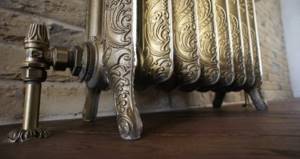
Modern designers have managed to diversify the appearance of retro models, however, even with the help of high-tech equipment, it has not yet been possible to increase the heat transfer of such batteries. This lies in the characteristics of the thermal conductivity of the material itself - gray cast iron. Many manufacturers solve the problem by increasing the volume of the radiator and cleverly interweaving sections. Batteries made of steel will have better thermal conductivity; however, retro versions made of this material are not easy to find on the modern market.
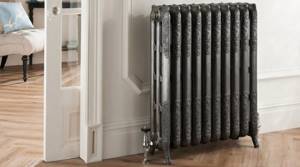
Manufacturers of antique radiators
If we rely on the technical parameters of cast iron systems, then batteries manufactured by Russian companies are better suited to the existing heating system. They can withstand pressures of up to 10 bar, which is only possible by products from the Czech company Viadrus, which managed to adapt to the needs of Russian consumers. Retro-style devices from other countries are more suitable for autonomous heating systems, as they are designed for a maximum pressure of 6 to 9 bar.
Batteries in this style are produced by 2 manufacturers in Russia:
- "Radimax" presents devices under the general name "Retro Style". A special feature of the company is that it accepts individual orders from clients and takes into account their wishes for color, ornament and shape of the product. All work on painting patterns is carried out manually and in addition to applying any color from the RAL palette, you can order polishing of a retro radiator. The products are based on prototypes from the 18th and 19th centuries, but can withstand pressures of up to 9 bar. The number of sections included in the set from this company is 3 pieces. The weight of the lowest device DERBY M 200 is 4.8 kg (heat output is only 55 W), and the highest BRISTOL 800 is 18.6 kg with a thermal power of 221 W. The average weight of a section with an axial distance of 500 mm from this company is 11 kg and the heat transfer is 120 W, which is quite a lot.
- Exemet is a company that chose heaters from the 19th and early 20th centuries as prototypes. They can be installed in any heating circuit, both two-pipe and single-pipe. The company's specialists paint products using the powder method after prolonged heating in special ovens. This procedure allows you to completely remove moisture from the pores of the cast iron alloy, after which painting is carried out in 2-3 layers. A special feature of this company’s retro radiators is their color scheme. Although only the 10 primary colors of the palette are used, additional deep or light polishing followed by varnish or patination allows you to create real masterpieces endowed with individuality. Their main technical parameters are:
- Working pressure up to 9-10 Bar.
- Suitable for closed types of systems.
- Coolant temperature up to +110°C.
- Crimping pressure up to 15 atmospheres.
- Center distance from 230 mm to 790 mm.
- Thermal power, depending on the size of the device, varies from 76 W in the lowest and up to 222 W in the Mirabella 600 model.
One set of retro batteries from Exemet comes with two to four sections on legs. The products of both companies have already been tested by the domestic heating network and have shown their reliability. Retro batteries from foreign manufacturers are represented on the market by the following companies:
- The company Demir Döküm from Turkey is well known to domestic consumers. In their retro line they have 3 models with center distances of 500 mm, 600 mm and 800 mm with heat output from 120 W to 187 W.
- The Czech manufacturer Viadrus has been presenting its cast iron products in Russia for quite a long time to create an impeccable reputation among consumers. Their retro line includes 4 models with center distances from 270 mm to 450 mm. The heat output of the low radiator is 70 W, and the highest figure for Bohemia 450 is 230 W.
Retro products from these manufacturers are in demand, despite their high cost. The main feature of retro-style batteries is their installation, taking into account their weight and the fragility of the cast iron itself.
What manufacturers and stores offer
After visiting the store, do not rush to order the first model you like in appearance. First of all, it’s worth imagining – how well will it fit into the interior in style and size? The color can be changed, but other characteristics will have to be put up with for decades.
Range
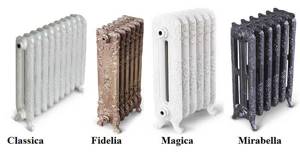
The best products of imported and Russian production.
- Almost all specimens are equipped with legs. This is not only a tribute to fashion and style, the heavy device will not fall off the holders or distort the pipes. The legs are decorated with patterns to match the overall design.
- Most of the proposals are made in Rococo, Empire or Baroque styles. If ornate ornaments seem too intrusive to you, it is possible to choose more laconic radiators.
- The valves match the style and color; they also have a decorative function, complementing the design concept.
- The color range is calm, from light gray to almost black, from milky to beige and dark brown. Additionally, silver and gold are available, with a glossy or patinated surface.
Note! It is possible to repaint the sections in a suitable color if desired and make minor adjustments. The instructions recommend doing this before connecting the device to the coolant.
Prices
- The average cost of a set of 10 sections from a domestic manufacturer will cost you from 12 to 40 thousand rubles.
- Polish analogues are slightly more expensive (from 19,000 rubles and above). Approximately the same price will be used for devices from Turkey.
- Batteries from Germany and France cost 45-48 thousand for the same 10 sections.
- Amenities priced from RUB 120,000. offered by manufacturers from the UK.
- China has, as always, a budget offer. For their product you will pay from 17,500 to 22,000 rubles for a 10-section device.
- A set of decorative valves will cost about 7,000 rubles.
Restoration of old batteries
Even the most reliable and durable device needs updating from time to time. Restoring cast iron batteries is not difficult and is quite accessible even to a beginner. If the product has an ornament, it should first be covered in order to paint the main surface of the product. The most important thing in this work is the choice of paint. The most popular are water-dispersion-based products, which dry almost immediately and do not have a pronounced odor, and alkyd enamels, which have a beautiful shine and are resistant to very high temperatures and abrasion.
To restore an old battery, you need to follow a simple sequence of actions:
- First of all, the layer of old paint is removed, for which you can use any universal solvent. It is better to buy it in aerosol form .
- If there is rust, it needs to be cleaned off.
- Degreasing the surface before painting is mandatory.
- Applying a primer, for which it is better to choose a product with anti-corrosion properties.
- Apply paint to the prepared battery.
